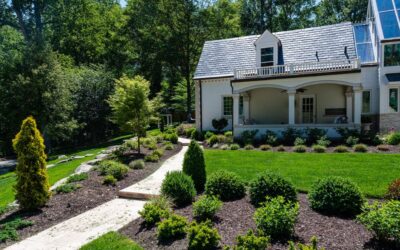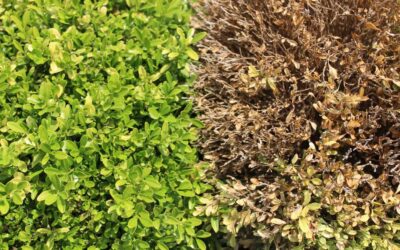Blog Topics
Boxwood blight is one of the most common and lethal plant diseases seen in Northern Virginia landscapes.
As the name suggests, boxwood blight is a disease that only affects boxwood (genus Buxus). However, there are several common landscape plants that can host the fungal pathogen (Calonectria pseudonaviculata) that causes the disease. These include the plants from the Buxus family:
- Japanese spurge (Pachysandra terminalis)
- Allegheny spurge (Pachysandra procumbens)
- Sweetbox (Sarcococca species)
Keep these plants well away from your boxwoods to help reduce their ability to spread the boxwood blight pathogen to your boxwoods.
Symptoms of Boxwood Blight
When you look at the boxwood planted in your garden, check for the following:
- Leaf spots that are circular, light to dark brown, and with dark borders
- Infected stems with dark brown to black, elongated cankers
- Rapid defoliation, especially in the lower canopy
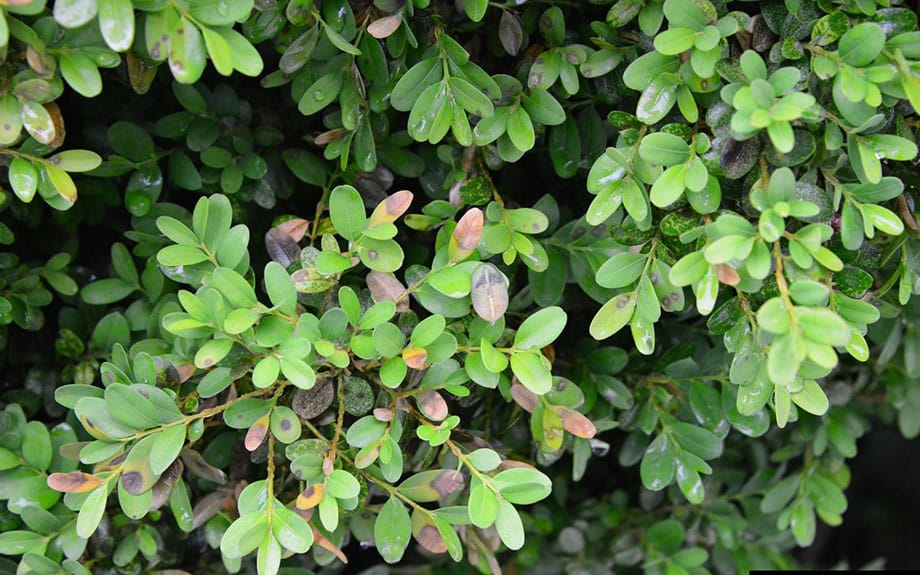
Leaf spots and early symptoms of boxwood blight
Image courtesy of David L. Clement, University of Maryland, Bugwood.org
How to Control Boxwood Blight
There is currently no cure for boxwood blight so homeowners and landscape professionals focus on ways to control the spread of this lethal disease.
Apply Fungicides
Fungicides are only preventive for boxwood blight management; they don’t kill the pathogen or cure the disease.
When spraying fungicides, remember that:
- Fungicide applications can suppress symptom development and prevent further spread but do not cure the plant from infection
- It’s difficult to get full coverage because of the dense, compact growing habit of boxwood
- Spray the boxwood thoroughly until you see spray run-off
- Spray fungicides on both the front and back of leaves and stems to ensure all surfaces are covered
NOTE: We use preventive management practices designed to avoid the movement of boxwood blight among customers’ gardens, so you can rest easy knowing that your healthy boxwoods are not at risk from the work we perform on your property.
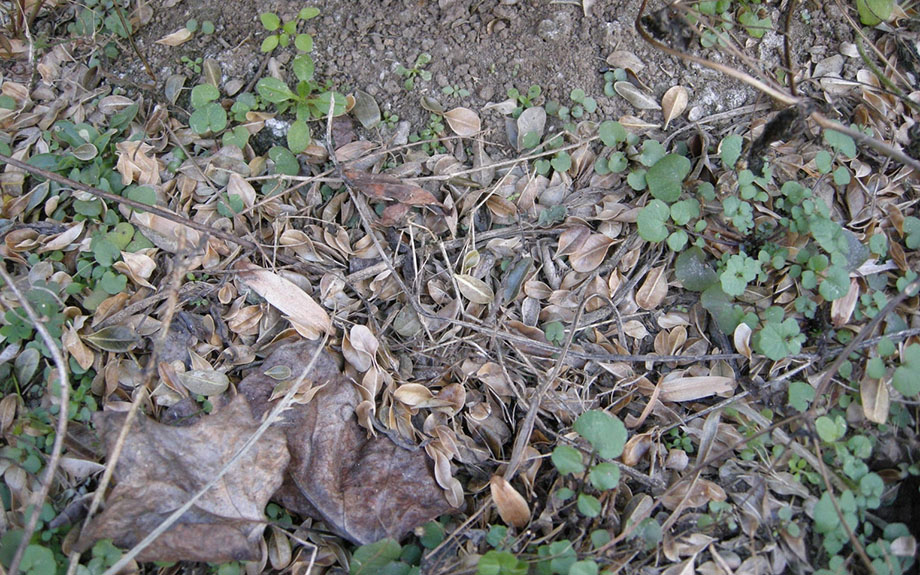
All fallen leaves and other debris beneath an infected boxwood should be removed and disposed of in a sealed trash bag.
Image courtesy of Mary Ann Hansen, Virginia Polytechnic Institute and State University, Bugwood.org
Remove Infected Shrubs & Debris
Since boxwood blight cannot be effectively controlled once the infection begins, we recommend prompt removal of any diseased boxwood, including roots. Shrubs that remain in place are likely to spread the disease to healthy plants.
All associated leaf debris should also be removed.
Do not place diseased material in your compost bin. Put it in a plastic bag, tie it securely, and dispose of it in the trash.
Although removing diseased boxwood and leaf debris is a necessary step in controlling the spread of boxwood blight, it will not eradicate the pathogen from the location. The pathogen produces fungal structures that can survive in the soil for 5 to 6 years and quickly infect susceptible replacement boxwood planted in locations where the disease has been diagnosed. Always be careful when introducing new, healthy boxwood into infected areas, and avoid bringing infected boxwood specimens into your garden.
Water Carefully
Water is an important way in which the disease can be spread. Make sure your irrigation or hand watering follow these guidelines:
- Avoid overhead watering when possible
- Water plants in the morning hours unless weather conditions require additional watering
- Direct runoff water away from other boxwood or other host plant species
Do Not Shear Boxwoods
If there was ever a good reason to stop shearing your plants, this is it.
With certain exceptions, shearing is not recommended by landscape professionals because of its detrimental effects on plants. To keep boxwood blight at bay, it’s best to use pruning strategies that open up the crown of plants to promote airflow and help leaves dry more quickly.
When pruning boxwood shrubs, follow these guidelines:
- The best method for shaping your boxwood is to use thoughtful, routine hand pruning to ensure that they maintain a balanced and healthy form
- Disinfect your tools between plants using a diluted bleach mixture
- When pruning, prune only what is required to shape and improve the plant’s structure – over-pruning stresses plants, making them more susceptible to pests and pathogens
- Prune boxwood in a peaked form (narrower at the top than at the bottom) to provide more opportunity for sunlight and airflow throughout the entire plant structure
- Remove lower branches and leaves by pruning (never pull or snap them off, even if they’re dead)
- To prevent the spread of blight spores, avoid pruning when foliage is wet
- Increase airflow by pruning up the lowest branches on surrounding trees and large shrubs
- Spread mulch around your boxwoods and maintain soil fertility to help keep your plants growing vigorously
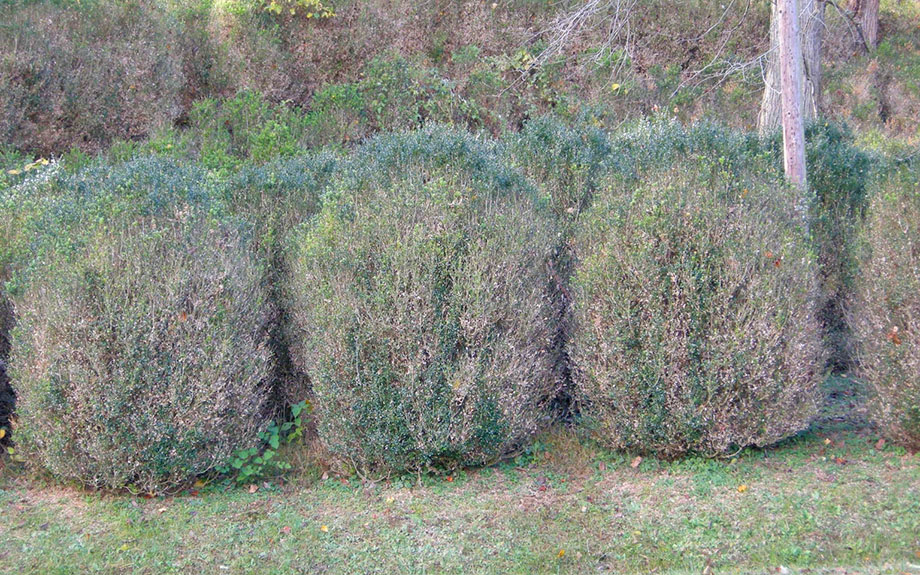
Boxwood blight (on sheared boxwoods) causes leaf necrosis and rapid defoliation
Image courtesy of Mary Ann Hansen, Virginia Polytechnic Institute and State University, Bugwood.org
Not All Boxwoods Are Created Equal
The commonly used Buxus sempervirens ‘Suffruticosa’ is highly susceptible to boxwood blight. Thankfully, other boxwood cultivars have shown greater resistance to boxwood blight.
If you are planning on adding new boxwoods to your garden, consider choosing from among the most resistant cultivars that are recommended for new plantings:
- Buxus microphylla ‘Golden Dream,’ Golden Dream Boxwood
- harlandii, Harland Boxwood
- sinica var. insularis ‘Nana,’ Insularis Boxwood
- microphylla var. japonica ‘Green Beauty,’ Green Beauty Little Leaf Boxwood
And if you’re replanting in a location where infected boxwood has been removed, always use resistant cultivars. Susceptible shrubs planted in that area will just need to be removed again next year when they succumb to the blight.
It’s a good idea to treat replacement boxwood cultivars with fungicide treatments to avoid infection, although cultivars with a very high level of resistance should be ok without it.
Need a Hand?
Boxwood is a beautiful, evergreen shrub that lends a certain elegance to the landscape. If you’d like to make sure your boxwood shrubs stay healthy, or would like suggestions and planting assistance for resistant varieties, give us a call. We can also help you choose boxwood alternatives that can create a similar look in your landscape without the disease potential and need for frequent treatments.
Give Us a Call at 703-402-9366
If you'd like help with your trees or landscape, have any questions, or would like to schedule an appointment with one of our Certified Arborists, please give us a call. We'd love to hear from you!

